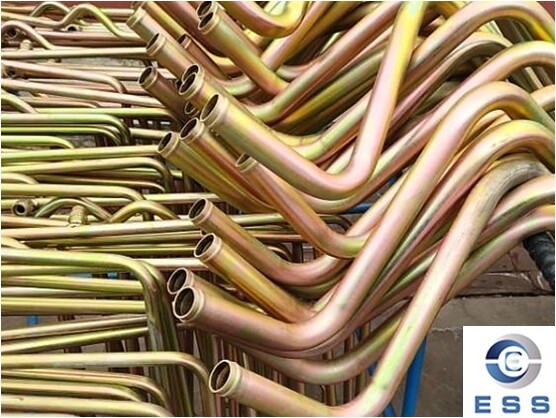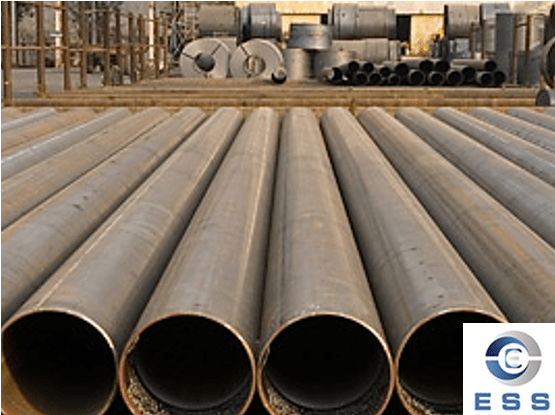
Hard tube and soft tube of hydraulic
tubes are commonly used pipe forms in hydraulic system, and they have their
own advantages in structure, characteristics and application. Choosing the
right hydraulic tube requires comprehensive consideration of the system's
working conditions, installation environment and maintenance requirements. The
following details the differences between the two in various aspects and other
key factors.
Structure
Hard hydraulic tubes are usually made of
metal materials (such as steel, copper, aluminum, etc.), with strong rigidity
and pressure resistance. Among them, seamless
steel pipe is the common material for hard hydraulic tubes, and the inner
wall is usually smooth, which can reduce the pressure drop in the hydraulic
system.
Soft hydraulic tubes are usually composed
of an inner layer pipe, a reinforcement layer (such as steel wire braid, steel
wire spiral, etc.) and an outer protective layer, which have certain softness
and bending properties. In some applications, soft hydraulic tubes can also be
used in conjunction with casing pipe to
provide additional external protection for the system.
Bending performance
Hard hydraulic tubes are relatively rigid
and difficult to bend. Their bending radius is relatively large. When
installing, the routing and layout space need to be considered. They are
suitable for straight or large bending radius pipeline design.
Soft hydraulic tubes are more flexible and
can be bent and adapted to different installation environments more easily.
Therefore, they are more suitable for occasions where frequent bending is
required, but excessive bending may also accelerate aging.
Pressure resistance
Hard hydraulic tubes usually have high
pressure resistance and can withstand large working pressures. They are
suitable for high-pressure environments. At the same time, metal materials have
good adaptability to temperature and medium chemical properties. The excellent
pressure resistance of hard tubes also makes them outstanding in some extreme
environments, such as oil drilling equipment used in conjunction with drill pipe.
The pressure resistance of soft hydraulic
tubes is relatively low, which is usually limited by the structure of its inner
layer and reinforcement layer. Generally, it is necessary to select the
appropriate hose type and specifications according to the working conditions.
Temperature adaptability
Hard hydraulic tubes can generally
withstand a wider temperature range and are suitable for high or low
temperature environments.
The performance of soft hydraulic tubes may
decrease at extreme temperatures, so it is necessary to refer to the product
description when selecting.
Safety and failure modes
Hard hydraulic tubes are prone to cracks or
breaks under overpressure or improper installation, and the risk of failure is
relatively high.
Soft hydraulic tubes usually show gradual
leakage when they fail, and there are usually obvious signs of aging or wear in
the early stage, which is convenient for early prevention and replacement.
Fluid dynamics
The inner wall of hard hydraulic tubes is
usually smoother, which is conducive to reducing fluid resistance and pressure
loss.
Soft hydraulic tubes can also maintain good
fluid transmission under reasonable design, but after long-term bending, they
may produce additional resistance due to wear of the inner wall.
Vibration and shock absorption capacity
Hard hydraulic tubes may require additional
support or vibration reduction measures in high vibration environments to
prevent breakage.
Soft hydraulic tubes can effectively absorb
vibration and shock due to their good flexibility and reduce system fatigue.
Installation and replacement
Hard hydraulic tubes are relatively
complicated to install and replace, requiring welding, threaded connection or
special joints. The construction process requirements are high, and
professional personnel are required for maintenance.
Soft hydraulic tubes use simple
installation methods such as end crimping, threaded connection or clamp
clamping, which is easy to replace and adjust. In addition, hydraulic hoses are
often connected by pup joints in some applications to further simplify the pipeline layout.
Cost and maintenance
Hard hydraulic tubes have higher initial
investment due to their expensive materials and installation process, but they
have a longer life and lower failure rate in a stable operating system;
however, once damaged, they are difficult to repair.
Soft hydraulic tubes have relatively low
material costs and installation costs, and are easy to repair and replace, but
they may age prematurely due to fatigue in the case of long-term or
high-frequency bending, and need to be inspected and replaced regularly.
Summary
Hard hydraulic tubes or hoses need to be
selected according to the specific hydraulic system requirements and working
environment. When selecting, factors such as the characteristics of the
conveying medium, working pressure, temperature range, safety requirements, and
budget should be considered. If you are not sure, it is best to consult a
professional hydraulic engineer or supplier for accurate advice.













 Eastern Steel Manufacturing Co.,Ltd not only improve product production and sales services, but also provide additional value-added services. As long as you need, we can complete your specific needs together.
Eastern Steel Manufacturing Co.,Ltd not only improve product production and sales services, but also provide additional value-added services. As long as you need, we can complete your specific needs together.










